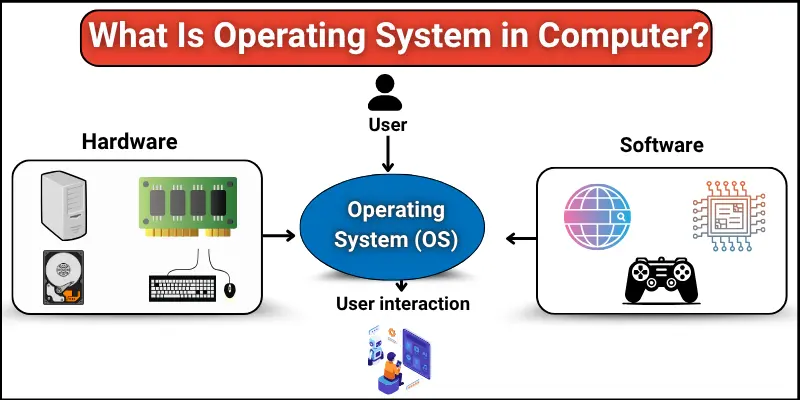Operating system in computer – Easy Guide for You
Published: 16 Nov 2025
Did you know that every computer, smartphone, or tablet requires an operating system to function? Sometimes, your computer may be slow, or apps don’t open properly. The reason is often the operating system. But knowing what is operating system in computer can help you understand how it manages programs, memory, and files to make your computer faster and easier to use.

What is operating system in computer?
An operating system is the software that makes a computer come to life. It enables hardware and applications to communicate with each other. The OS organizes files, handles memory, and manages the programs you use every day. It also lets you control the computer through its interface. Without an OS, a computer would not be able to perform anything.
Types of Operating Systems
There are many types of operating systems. Each type works in a different way and is used for different purposes.
1. Batch Operating System: Processes jobs in batches without user interaction.
2. Time-Sharing / Multitasking OS: It allows many users or programs to use the computer at the same time.
3. Distributed Operating System: It controls many computers connected in a network as one system.
4. Real-Time OS: Works instantly and is used in devices that need fast responses.
5. Network OS: It helps computers communicate and share resources in a network.
6. Mobile OS: It is used in smartphones and tablets to run apps and manage hardware.
Functions of an Operating System
An operating system has many important jobs. It helps the computer run smoothly and makes it easy for users. Here are the main functions:
1. Managing Hardware: Controls CPU, memory, storage, and other devices.
2. Managing Software/Applications: Runs programs and manages multiple apps at the same time.
3. File Management: Organizes, stores, and retrieves files on the computer.
4. Security and Access Control: Protects the computer from unauthorized access and threats.
Examples of Operating Systems
There are many operating systems used on computers, smartphones, and tablets. Here are some popular examples of operating systems.
- Windows: Windows is a widely used operating system on many home computers and laptops. It is easy to use and helps you open apps, play games, and complete schoolwork.
- macOS is used in Apple computers, such as the MacBook and iMac. It is smooth, fast, and designed to work perfectly with Apple devices.
- Linux: A free and open-source OS used on computers and servers.
- Android: Used on most smartphones and tablets.
- iOS: Used on Apple devices like iPhone and iPad.
Components of an Operating System
An operating system has different parts that help it work properly. Here are the main components:
- Kernel: The core part that controls hardware and system resources.
- Shell: Lets users give commands to the computer.
- File System: Stores, organizes, and manages all computer files.
- Device drivers help the OS communicate with hardware, such as printers and keyboards.
Advantages of an Operating System
An operating system makes computers easy to use. It helps programs run smoothly and keeps everything organized. Here are the main advantages:
| Benefits |
|---|
|
Disadvantages of an Operating System
Although operating systems are helpful, they can also have some issues. Here are the main disadvantages:
| Disadvantages |
|---|
|
Conclusion
So guys, it’s time to finish up! In this article, we’ve covered the Operating System in computer in detail. My advice is to choose an OS that suits your needs, whether for study, work, or gaming. A good OS makes using your computer simple and fun. Don’t stop here—check out other articles on our site to learn more tips about computer basics!
FAQs about the Operating System in computer
Below are a few simple questions people often have about the operating system.
A computer needs an operating system to manage resources like memory, CPU, and storage. It also provides an interface for users to interact with the computer. Without an OS, the computer cannot function.
The kernel is the core part of an OS. It controls the hardware and system resources. All major operations pass through the kernel.
Yes, this is called dual-boot or multi-boot. You can choose which OS to start when the computer turns on. It helps if you want to use different OS for different tasks.
A good OS manages memory, CPU, and storage efficiently. It controls background tasks and runs multiple programs smoothly. A poorly optimized OS can slow down your computer.
Yes, mobile OS like Android and iOS are designed for smartphones and tablets. They are lighter and optimized for touch screens. Computer OS like Windows and macOS are built for laptops and desktops.
A real-time OS responds instantly to inputs. It is used in devices like medical machines and airplanes. It ensures fast and accurate results.
A network OS helps computers connect and share files in a network. It allows multiple users to access resources at the same time. It is used in offices and schools.
Yes, an OS can sometimes crash due to a bug or a hardware problem. When this happens, the computer may freeze or restart. Updating the OS regularly can reduce crashes.
Yes, every OS provides a way for users to interact, called a user interface. This can be graphical (GUI) or text-based (CLI). It makes using the computer easier and more fun.

- Be Respectful
- Stay Relevant
- Stay Positive
- True Feedback
- Encourage Discussion
- Avoid Spamming
- No Fake News
- Don't Copy-Paste
- No Personal Attacks

- Be Respectful
- Stay Relevant
- Stay Positive
- True Feedback
- Encourage Discussion
- Avoid Spamming
- No Fake News
- Don't Copy-Paste
- No Personal Attacks
